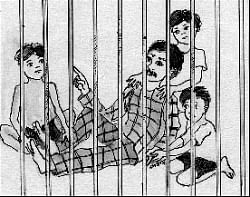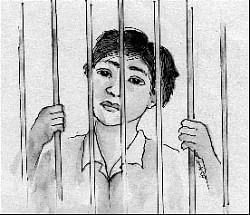Children
in custody still denied justice
Md
Nur Islam
The number of juvenile
delinquents are not negligible. Most of those children delinquents are
languishing in the jail custody with total denial of their rights. Since
crime is a social malady children are often vulnerable to it. When children
are not be brought up in a desired and congenial environment, they tend
to be involved in different types of crime and finally discover themselves
to be delinquents. No child is born as a delinquent. The parents of each
child harbour future dreams to their children but many of the dreams do
not come into reality because of the adversaries of the society. Keeping
this view in mind, the juvenile justice system should be given its due
priority with regard to necessary developments and substantive changes
in the enactment. For that end, juvenile justice system should not be
confined to only the treatment of children when they come in conflict
with the laws but to include the root causes behind the delinquent behaviour
and the measures to prevent them.
In 1974 a comprehensive
children Act was enacted, it has also got a complementary, namely, the
children rules-1976. And the cases of children supposed to be governed
by Act aided by the criminal procedure code & the penal code.
 Definition
of children
Definition
of children
The different laws have defined children in different ways. But for the
very purpose of this system, the children Act has defined a child as any
person under the age of 16 years. The convention on the rights of children
(CRC) defines a child as any person under the age of 18 years.
Juvenile
justice and court
Juvenile justice has become an international issue with introduction of
the convention on the rights of the child (CRC) coming into force in 1990.
The essential element of a juvenile justice system is an attitude. An
attitude that values each boy and girl who is in the justice system and
cares about how the experiences in the system will shape the life of each
one of them. The manner in which police arrest or interrogate a youngster,
the way judges make decisions about guilt or sentencing, the educational,
recreational and safety conditions in detention facilities, the programs
for rehabilitation and reintegration that is to say every component of
the entire system must be constructed to prevent humiliation and avoidable
suffering. Juvenile justice in a broader sense not only includes the treatment
of children when they come in conflict with the law, but also involves
the root causes of the offending behaviours and the measures to prevent
them.
In infringement of
international standards, juvenile inmates are often held together with
adults. A study shows that there are 1063 children in 60 jails and 280
more in the correction centers in Bangladesh. Many of Bangladeshi's jail
and police lock-ups mix juvenile and adult prisoners. Children in such
circumstances, frequently fall victim to bodily abuse, including sodomy
and rape by adult inmates. In such a situation the appropriate measures
have to be taken with a view to eradicate the impediments as existed in
our juvenile justice system.
The
children Act 1974 was enacted to consolidate and amend the hitherto existing
laws relating to the custody, protection and treatment of children and
trial and punishment to young offenders. This Act has laid down the provision
for establishing the juvenile courts for any local area for the purpose
of the trial of the youthful offenders. The section 3 of the Act says"
Not withstanding anything contained in the code, the government may be
by notification in the official gazette, establish one or more juvenile
courts for any local area. The section 4 of the act has provided provision
to exercise the powers of juvenile courts by (a) the High Court Division
(b) a court of sessions (c) a court of an additional sessions judge and
of an assistant sessions judge, a sub divisional magistrate (district
magistrate), a magistrate of the first class. The section 5 of the act
deals with the power of the juvenile courts while the section 6 suggest
separate trial of the children accused, the section 7 regarding the holding
of setting of the courts, the section 9,10,11,12,13,14 and 15 are procedural
in nature. The part viii of the act has dealt with the provisions regarding
the bail of the offenders, the restriction on punishment, power to discharge
or commit in suitable custody etc as espoused in section 48-54 while the
part viii of the same act as enshrined in sections 55-61 has exposed the
provisions regarding definition, supervisions ect of the victimised children.
The demands of establishing juvenile court and the separate trial of the
juvenile offender are getting momentum in our country. The need for separate
juvenile court is being emphasised in workshop, seminar etc by the conscious
section of the people.
Age
determination factor
For smooth and proper functioning of juvenile justice system, the determination
of age is a must. In laws of Bangladesh there is no uniform definition
of children, the different laws define children differently Apart from
this, the birth registration mechanism is very poor in our country and
the same is not properly and adequately maintained and, as such, the concerned
authority has to depend on mere inference and speculation while determining
age of children. In this respect a proper device with determining the
age of children should be chalked out. If need be, laws will be amended
in case of juvenile justice to ensure that the age of a child offender
is determined by the date of the offence committed.
Serious
contradiction in laws
There is also a serious contradiction in laws, while the children Act
terms the under-16 as minor, the majority Act 1875 terms all the citizens
under 18 years as the same too. The government must revise the relevant
laws in order to remove the inconsistencies. Moreover, this Act is silent
about exploitation of children in the name of family enterprise/businesses.
The issue is whether such exploitation in the name of family business
is punishable or not.
 Recent
development at abroad
Recent
development at abroad
International treaties and customary international law forbid capital
punishment for offenders under the age of 18 at the time of the offence
for which they were convicted. Iran, Saudi Arabia, Nigeria and the Democratic
Republic of Congo are the only countries that are known to defy the world
wide consensus that the death penalty should not be imposed on juvenile
offenders. Recently, the governors of two states, South Dakota and Wyoming
have signed the legislation raising the minimum age for capital punishment
in their states to 18. In the United States, 31 states and the federal
government now prohibit the execution of juvenile offenders.
Some
major obstacles
Poverty is major reason behind juvenile offence in a country where 48
percent people live under the poverty line; Most significant problem is
ignorance of magistrates, law enforcement agencies and probation officer
about the legal approach to children; Lack of training of magistrates
and other law-enforcers on how to deal with children that impedes greater
prevention of abuse of troubled children; Lack of society or community
mechanism to address child-rights issues; Lack of relevant amendment,
proper interpretation and understanding of the children Act, 1974 and
children Rules, 1976; The existence of the 1943 vagrancy Act, which is
said to be 'anti poor' and 'counter constitutional'; and lack of co-ordination
among the government agencies.
Some
recommendations
Reduction of poverty and socio-political instability should be viewed
as fundamental changes that could positively change people's mind set
towards children; a greater bondage between parents and children and lower
incidence of broken homes could reduce the problem of children pushed
towards crime; co-ordination between magistrates, policemen and probationer
officers have to developed; And a greater awareness is needed among government
workers about sensitivities in dealing with juvenile offender.
Concluding
remarks
Juvenile justice is something completely different from criminal justice.
Protective legislations and their proper implementation through an effective
child-friendly legal system based on ground reality can safeguard the
rights of juvenile offenders. A creative approach is necessary to improve
the juvenile justice system and establish a just society. Only new thinking,
new values, new projection and positive outlook with determined action
can achieve this. With a humble hope of due consideration of authorities
for enactment of adequate laws in this regard, this work is concluded
herein.
The
author is a Senior Assistant Judge.